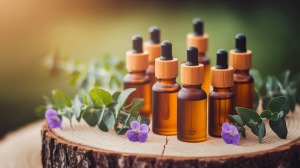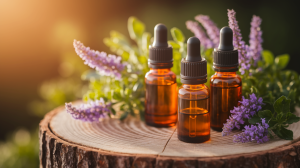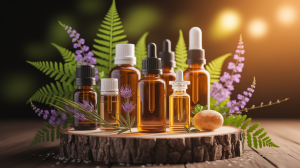Chemotypes Uncovered: Your Quickstart Guide
I still remember the first time I spotted two bottles of rosemary essential oil sitting side-by-side on a shop shelf. Same plant name, same brand, but one had “ct. camphor” on the label and the other “ct. 1,8-cineole.” I actually picked them up and sniffed each like I’d accidentally uncovered some sort of botanical magic trick. And here’s the secret—these weren’t just fancy labels. They were different essential oil chemotypes, and that one little detail changes everything about how you might use them.

Chemotypes are essentially nature’s way of giving a plant more than one “chemical personality.” They come from the same species—no visible changes in leaves or flowers—but in their oil, certain chemical constituents like camphor, 1,8-cineole, linalool, or thymol dominate. These variations affect their scent, therapeutic uses, and even safety considerations in aromatherapy science. It’s a bit like identical twins who have completely different tastes in music—they may look the same, but what’s going on inside is another story entirely.
The Roots of Chemical Variation
The “personality shift” in essential oils often comes down to an intricate mix of plant genetics and environmental factors. Tiny tweaks in the plant’s living conditions—like whether it’s growing on a breezy mountainside or in a warm, coastal valley—can reshape the balance of volatile organic compounds like monoterpenes, sesquiterpenes, or oxides. Even the harvest season plays a part. For example, peppermint’s levels of linalool and linalyl acetate can shift during different points in its growth cycle—a kind of seasonal quirk that might seem like a whole new chemotype but is just a passing phase in its phytochemistry.

I once smelled a peppermint distillation straight from a summer harvest in high heat—it was sharp, fresh, and invigorating. Then I compared it to an early spring distillation from the same farm, and the aroma practically wrapped around me like a soft blanket. These little differences are the reasons you can have “geographic chemotypes” or even “seasonal variations” that redefine your expectations of a familiar oil.
Spotting Chemotypes on Your Bottle
Now, here’s a little detective work you can do at home. When you pick up a bottle, check the label for a “ct.” followed by a compound name—like “Rosmarinus officinalis ct. camphor.” That’s your chemotype. Without it, you’re flying blind. Chemotype labeling is your direct clue as to whether the oil is going to clear your mind, soothe sore muscles, or something else entirely.

Reliable suppliers usually confirm this through gas chromatography-mass spectrometry (GC-MS) testing—a sort of chemical fingerprinting that unpacks all the aromatic compounds in the bottle. This precision is not about being fussy; it’s about safety, efficacy, and avoiding surprises, like expecting calming effects when what you’ve got is more stimulating in nature.
Chemotype Choices and Therapeutic Effects
Here’s where the magic meets reality. Switching from one chemotype to another can be the difference between easing a headache and helping a cough. Rosemary ct. camphor tends to be a dynamo for muscle aches—the camphor content works like a stimulating nudge to tense tissue. On the other hand, rosemary ct. 1,8-cineole leans toward clearing respiratory pathways, thanks to its mucolytic oxides. Neither is better in a general sense—they’re just better at different jobs.

And this is why knowing “what’s in your bottle” matters. Those major players in the oil—whether they’re terpenes, phenols, ketones, or esters—are ultimately what dictate the oil’s therapeutic properties and safety. An oil high in certain phenols might be powerfully antimicrobial but could also irritate skin if used neat. These little chemistry details quietly steer your blends towards success or disappointment.
Your Roadmap to Precision Aromatherapy
If there’s one thing I’ve learned, it’s that picking the right chemotype is like choosing the right tool from a toolbox. You wouldn’t use a hammer to tighten a screw, right? In aromatherapy, reaching for a “one-size-fits-all” oil can mean missing the mark completely. The roadmap starts with identifying your needs—respiratory, muscular, calming, uplifting—and then matching them to the chemotype’s dominant bioactive compounds.

- Identify your therapeutic goal clearly.
- Check the oil’s chemotype on the label.
- Confirm quality through GC-MS reports when possible.
- Understand the safety considerations for that chemotype.
This approach blends the joy of using beautiful aromas with the groundedness of scientific accuracy in plant chemistry. Suddenly, you’re not just “using essential oils,” you’re aligning with the exact molecular structure that fits your need.
Aroma Mastery: Next Steps in Chemotype Selection
Once you’ve gotten comfortable identifying and using chemotypes, the fun really begins. You can start crafting blends that play to each chemotype’s strengths—layering eucalyptus ct. globulus for opening the breath with thyme ct. linalool for gentle immune support, for example. It’s like composing a song where each oil plays a note, and the chemotypes fine-tune the melody.
Exploring how to identify essential oil chemotypes isn’t just about precision—it’s about deepening your relationship with plant chemistry. Every “ct.” on your bottle is another opportunity to work hand in hand with nature’s quiet adaptations, to notice the subtle shift in aroma between an alpine or a coastal harvest, to catch those little human moments when an oil surprises you in the best way. And if you ask me, that’s where aromatherapy feels like pure magic—where science, scent, and story meet in a single drop.













